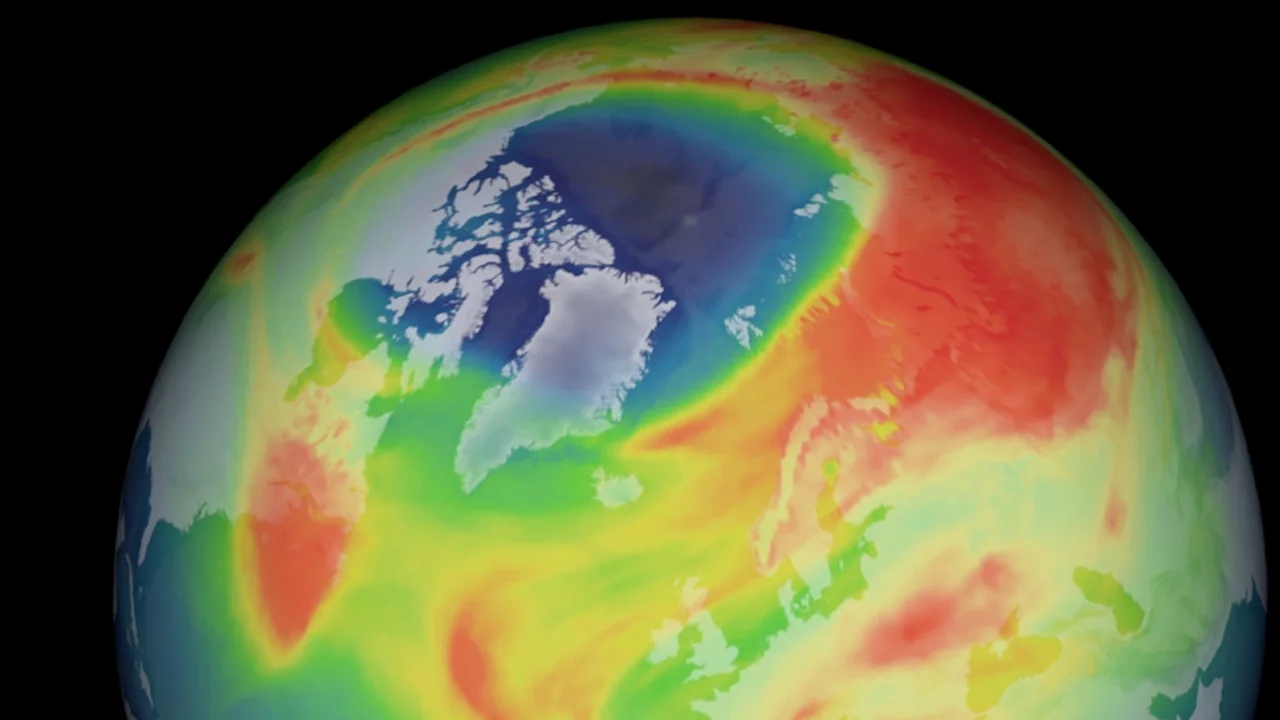
Rare record-setting Arctic ozone hole has finally closed
Satellites revealed the extent and persistence of this record-setting Arctic ozone hole
Earlier this year, a rare ozone hole opened up over the Arctic.
The largest so far on record, this enormous hole in the Arctic ozone layer formed in late February, persisted throughout March and is only now showing signs of sealing back up. That makes it the most persistent Arctic ozone hole on record as well.
The European Space Agency's Copernicus Sentinel-5P satellite watched this record-setting ozone hole through its peak.
"The Tropomi total ozone measurements are extending Europe's capability of the continuous global ozone monitoring from space since 1995. In this time, we have not witnessed an ozone hole formation of this size over the Arctic," Claus Zehner, ESA's Copernicus Sentinel-5P mission manager, said in an ESA press release.
"The ozone hole we observe over the Arctic this year has a maximum extension of less than 1 million sq km," Diego Loyola, from the German Aerospace Center's Remote Sensing Technology Institute, said in the press release. "This is small compared to the Antarctic hole, which can reach a size of around 20 to 25 million sq km with a normal duration of around 3 to 4 months."
NASA satellites have also been watching. Daily ozone levels over the past eight months reveal what typical winter ozone looks like over the Arctic, and then capturing this new hole starting in February.
At one point, in mid-March, this Arctic ozone hole stretched from James Bay to northern Siberia.
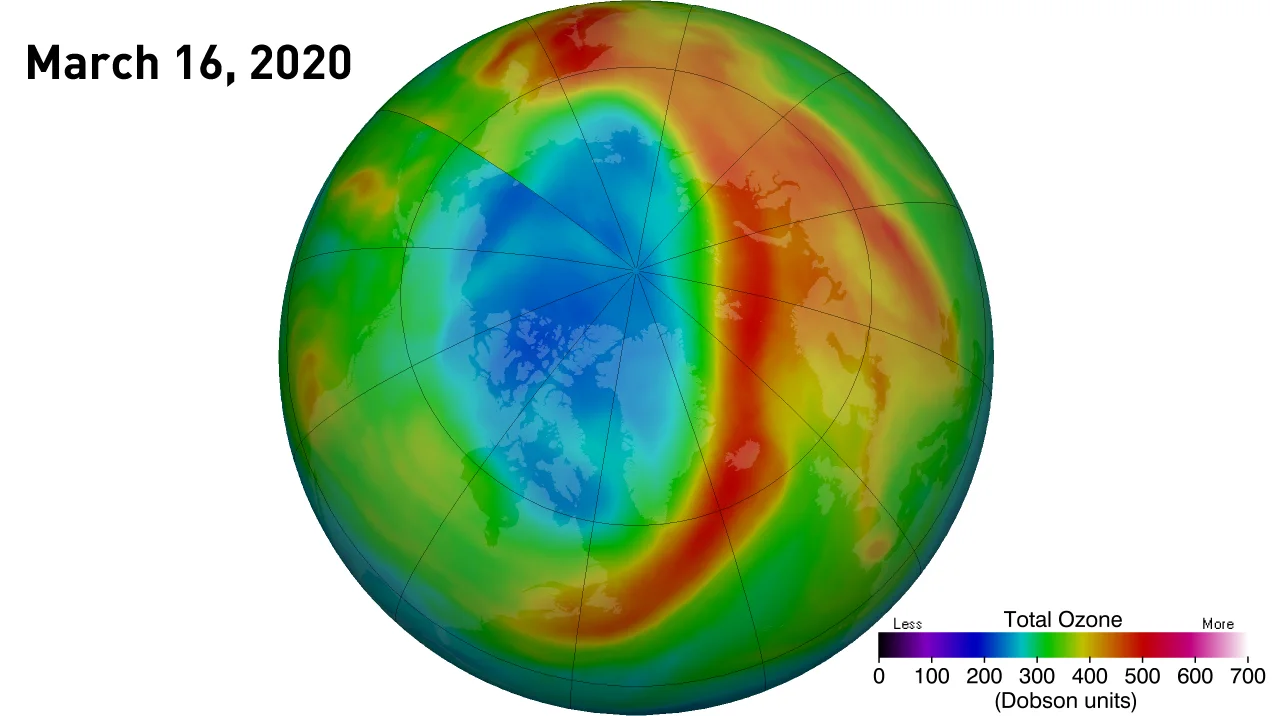
A 'true' ozone hole (in blues) grew to enormous size over the Arctic by mid-March, 2020. Credit: NASA Ozone Watch/Scott Sutherland
With stratospheric temperatures warming up as of late March, the source of this ozone hole - 'active chlorine' atoms resulting from a combination of chlorofluorocarbons (CFCs) and polar stratospheric clouds - dissipated.
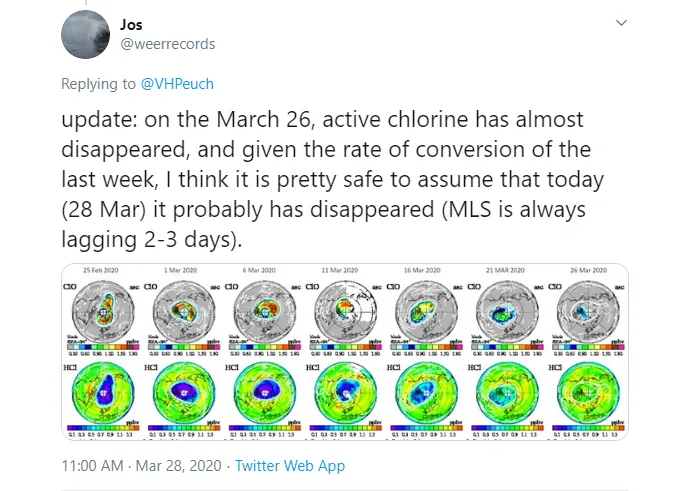
A tweet from Jos de Laat, senior scientist at the Royal Netherlands Meteorological Institute (KNMI), shows the presence and gradual disappearance of the two chemicals that represent 'active chlorine' in the stratosphere.
Since then, the Arctic ozone hole began to close, as the processes that produce ozone finally overtook those that cause ozone depletion.

Ozone levels, at weekly intervals from March 16 to April 13, show the Arctic ozone hole is gradually sealing up. Credit: NASA Ozone Watch/Scott Sutherland
WHY IS THIS HAPPENING?
Earth's ozone layer, located in the stratosphere at around 15-25 kilometres above the surface, acts as a protective shield against harmful ultraviolet radiation from the Sun. It has existed for as long as there was free oxygen in the planet's atmosphere. It forms as oxygen molecules absorb UV rays and split apart. The resulting oxygen atoms then join with oxygen molecules to produce ozone.

Ozone formation in the stratosphere. Credit: Scott Sutherland
This process, along with direct absorption by the resulting ozone molecules, prevents the most energetic ultraviolet rays (UV-C) from reaching the ground. Ozone also absorbs the less intense forms of UV light (UV-B and UV-A), partially filtering them, so only a small amount reaches the ground. Since the most energetic UV rays can damage the genetic codes (DNA) that we require to live, this filtering is essential for life on Earth.
In the past 40-50 years, however, human activities resulted in the release of an excess of chemicals known as chlorofluorocarbons (CFCs) into the atmosphere. Used as accelerants in spray cans, in various industrial processes, and in air conditioners and refrigerators, they were considered safe when they were at the normal temperatures and pressures we encounter in the troposphere - the lowest level of the atmosphere. When CFCs reach the stratosphere, however, the chlorine atoms contained in the molecules become a problem.
At very low temperatures (below -78°C), the minimal amount of water in the stratosphere forms 'polar stratospheric clouds'. When sunlight strikes these rainbow-hued clouds, the cloud droplets act as focal points for chemical reactions that result in 'active chlorine' atoms being released from CFCs. These active chlorine atoms then go on to break up ozone molecules, and one individual chlorine atom can destroy up to a hundred thousand ozone molecules before it is removed from the environment.
At the south pole, over Antarctica, winter stratospheric temperatures often reach down this cold, due to the particular weather conditions in that part of the world (strong polar vortex blowing around a frigid landmass surrounded by water). Thus, in August, as the region starts to see sunlight again in the latter half of southern winter, a large hole opens up in the ozone layer there, which typically persists until November or December each year.
The north pole is opposite to the south in more than one way, though. As an ocean surrounded by land masses, rather than a landmass surrounded by ocean, the Arctic polar vortex usually cannot get as strong as the one that blows around the Antarctic. Thus, stratospheric temperatures in the Arctic only dip down into nacreous-cloud-producing levels of cold during the darkest parts of winter. By the time the Sun is seen again in February, temperatures have warmed up enough that if any clouds had formed in the darkness, they would have already dissipated, leaving the Arctic ozone layer intact.
There are times when scientists observe 'mini-ozone holes'. These are small, temporary gaps or thinner areas in the ozone layer over the Arctic. They form simply due to wind patterns causing ozone to 'pile up' over some areas and grow thinner in others.
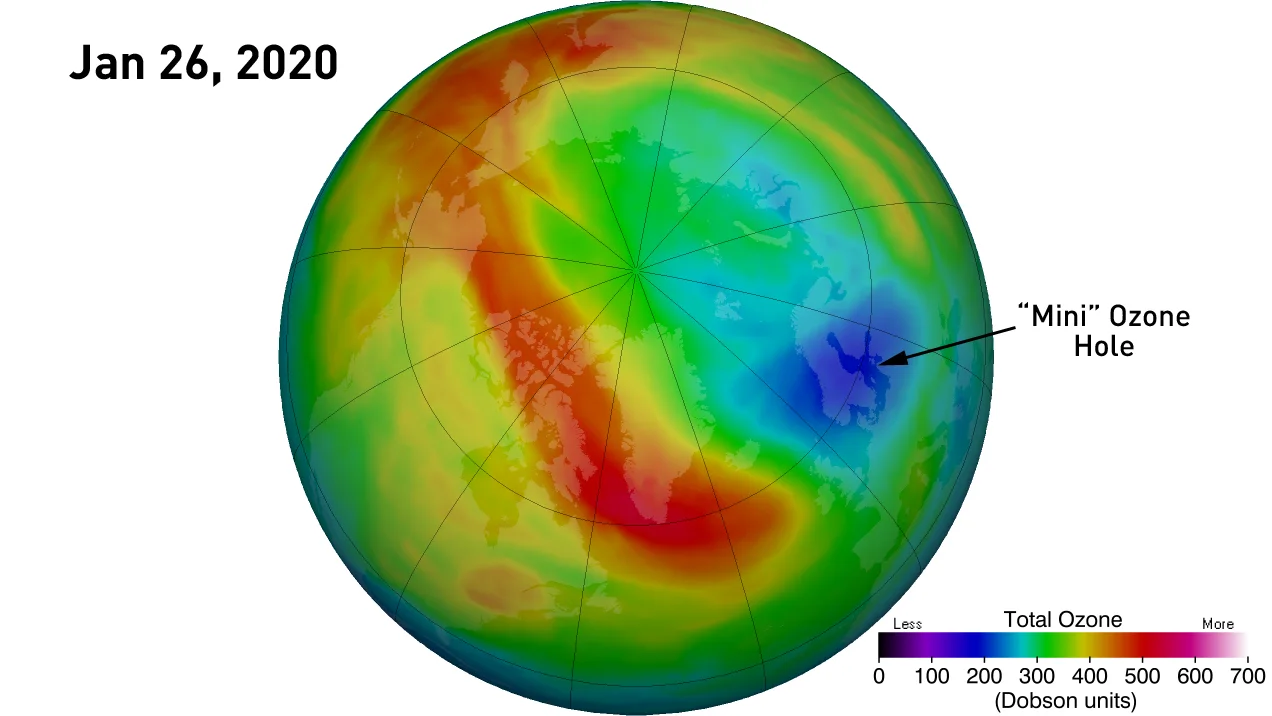
A mini-ozone hole (in blues) developed over the Arctic in late January 2020, due to ozone 'piling up' (in reds) over other regions. Credit: NASA Ozone Watch/Scott Sutherland
This winter, however, there was an exceptionally strong Arctic polar vortex, which allowed the stratosphere to dip down to near-record cold temperatures in January. An unusual cold-spell followed this through February, and record-setting cold stratospheric temperatures were seen through much of March.
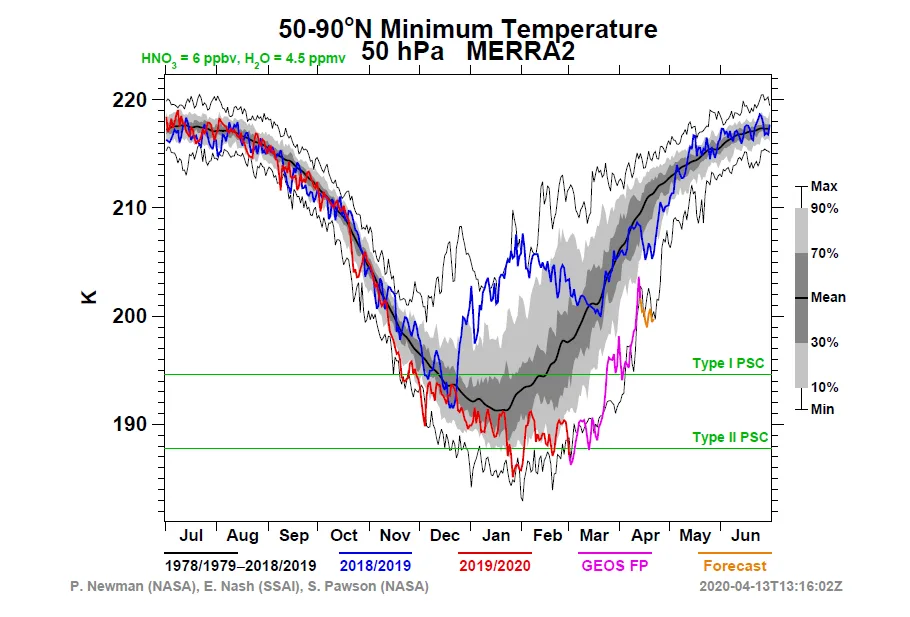
Arctic stratospheric temperatures throughout the year. The black line is the average from 1978/1979 through 2018/2019. The 2018/2019 line (blue) shows near-record warming through last year's winter. The 2019/2020 line (red, then purple and orange) shows how temperatures have progressed this past winter, up to April 13, 2020. Credit: NASA Ozone Watch/P. Newman (NASA)/E. Nash (SSAI)/S. Pawson (NASA)
These conditions allowed polar stratospheric clouds to persist much longer than they usually would. So, when sunlight fell on these clouds in February, the same ozone-depleting chemical reactions that plague the south pole opened up an actual ozone hole over the Arctic.
Once polar stratospheric temperatures warmed up enough, these clouds dissipated, which allowed the normal ozone-producing processes to take over once again.
Update: As of April 21, 2020, the Arctic ozone hole is now gone, with only a few patches of thinner ozone left behind in its 'wake'.
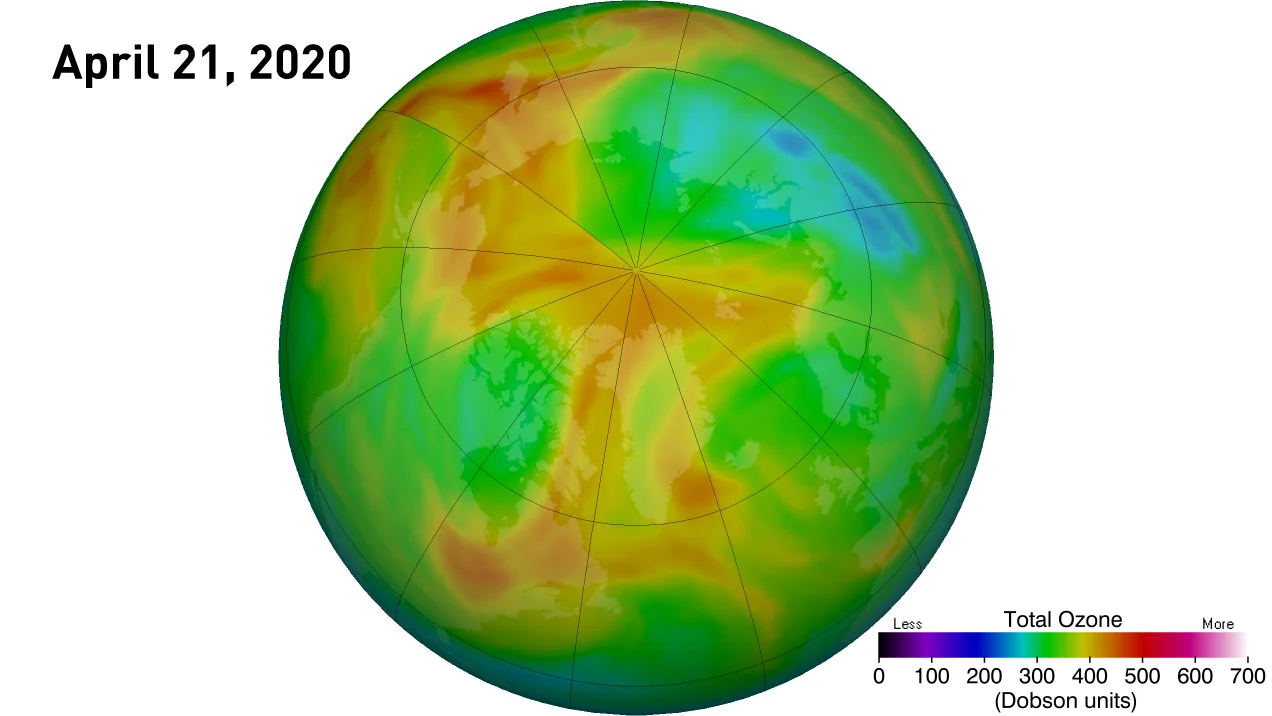
Arctic ozone levels as of April 21, 2020. Credit: NASA Ozone Watch/Scott Sutherland
Sources: NASA Ozone Watch | European Space Agency

